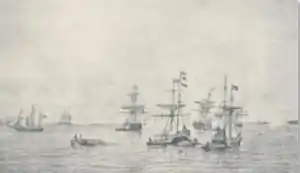Battle of Monte Santiago
The naval Battle of Monte Santiago was fought on 7–8 April 1827, between the Argentine Navy and Brazilian Imperial Navy, during the Cisplatine War. It was a decisive Brazilian victory, with the allied forces losing its best ships. The battle is highlighted by Argentine historians as one of the most courageous and ferocious naval encounters in the country's history.[1] On that day, Captain Francis Drummond (engaged to Admiral Brown's daughter Elisa) died on deck, firing his marooned ship's cannons instead of retreating.
| Battle of Monte Santiago | |||||||
|---|---|---|---|---|---|---|---|
| Part of Cisplatine War | |||||||
 | |||||||
| |||||||
| Belligerents | |||||||
| Commanders and leaders | |||||||
|
|
| ||||||
| Strength | |||||||
|
12 ships in the first day, 16 in the second 1 frigate 2 corvettes 8 brigs 7 schooners 2 boats 5 gunboat 229 cannon |
2 brigs 1 boat 1 schooner 63 cannon | ||||||
| Casualties and losses | |||||||
|
2 brigs sunk 1 brig and 2 schooners damaged 40+ dead and wounded |
2 brigs sunk 1 schooner damaged 75–150 dead and wounded | ||||||
Despite the fact that it did not change the status quo in the River Plate, it still represented a severe setback for the smaller Argentine Navy. From that moment on, only corsair raids against commerce ships could be undertaken by the Argentine Navy; and the Naval blockade posed grave problems to the export-oriented Argentine economy.[2]
The battle
The Brazilian Navy had high seas vessels, with more firepower but lesser speed; the Argentine Navy relied on fast maneuvering ships. Some Argentine commanders believed that the lack of manoeuvring of the Imperial vessels in shallow waters and the speed of their own ships could decide some engagements in their favour.
The Argentine squadron
| Vessel | Type | Tons burthen | Guns | Complement | Captain |
|---|---|---|---|---|---|
| Republica Argentina ex-Upton |
Brigantine | 150 | 4 × 8-pounder guns + 12 × 18-pounder carronades | 100 | William H. Granville |
| Independencia ex-Harmony |
Brigantine | 258 | 6 × 12-pounder + 10 × 8-pounder + 6 × 6-pounder guns | 120 | Francis Drummond |
| Congresso | Barque | 185 | 2 × 12-pounder + 16 × 8-pounder guns | 110 | William Mason |
| Sarandi | Schooner | 150 | 1 × 18-pounder + 2 × 6-pounder + 4 × 4-pounder guns | 90 | John Halstead Coe |
The Argentine commander was confident that, by using the surprise element, his more maneuverable ships could inflict damage and that he could escape before the Brazilian force could counterattack. However, he was unaware of the enemy's initial three-to-one advantage in terms of ships on the first day of battle (which escalated into a four-to-one advantage by the second day). Brown also underestimated the Brazilian fleet's ability to cut off any route of escaping in time. As a result, the battle was a two-day pouring of shells onto his men.
On the second day, the Brazilian vessel Dona Paula opened fire on the Argentinian brigantine Independencia. Independencia (which had lesser firepower) lost its masts, and to prevent the ship from sinking, twelve cannon were thrown overboard. As a consequence Francis Drummond, its captain, was wounded by a sliver that cut his ear. At 4 pm Drummond had no powder left, and had already fired his supply of three thousand rounds. Drummond managed to use anchor chains as ammunition. He ordered "abandon ship", but the crew fiercely refused his command. Then Drummond, in order to resupply ammunition, sailed in a lifeboat to the Argentinian flagship Republica. At that moment he was hit by a 24 lb (11 kg) cannonball that destroyed his pelvis and right leg, killing him.
Aftermath
The losses in this battle, along with the loss of the large Argentinian vessel 25 de Mayo in the battle of Punta Lara-Quilmes (June 29–30, 1826), kept the Brazilian Navy in control of the River Plate. From that moment on, only raids against commerce ships could be undertaken by the Argentine Navy, mostly from its Atlantic base at Carmen de Patagones, but no major operations to challenge the larger ships of the Brazilian Navy were possible. As the British military historian Brian Vale put it, "[...] Juncal had done little to push the Empire in the direction of peace. Now at Monte Santiago, two of Argentina's precious brigs-of-war had been destroyed and the cream of its Navy roundly defeated. The Brazilian Navy's overwhelming superiority at sea had been reasserted in a way which neither William Brown's audacity or Ramsay's newly purchased frigates could seriously challenge".[3]
The war reached a standstill: the Argentine Army had greater control in the land operations, but lacked the means to expel the Brazilian Army from Colonia and Montevideo, the two largest cities of Uruguay (which would remain under Brazilian control throughout the whole conflict), and lacked larger ships to challenge the control of the river; at the same time, the losses sustained by the Brazilians during the previous battles discouraged them from extending the naval war into the interior rivers of Argentina, and the shallow waters discouraged the attempt of a direct attack against Buenos Aires. This situation continued until the Preliminary Peace Convention, by which Oriental Province became the independent nation of Uruguay.
References
Notes
- Archived December 21, 2008, at the Wayback Machine
- "Los efectos de la guerra en la economía de las Provincias Unidas". Argentina-rree.com. Retrieved 2015-05-30.
- A War Betwixt Englishmen Brazil Against Argentina on the River Plate 1825-1830, Brian Vale, I. B. Tauris, page 137, chapter 14
Bibliography
- Scheina,Robert L. Latin America's Wars, Volume I: The Age of the Caudillo, 1791-1899, Potomac Books Inc., 2003, ISBN 1574884492
